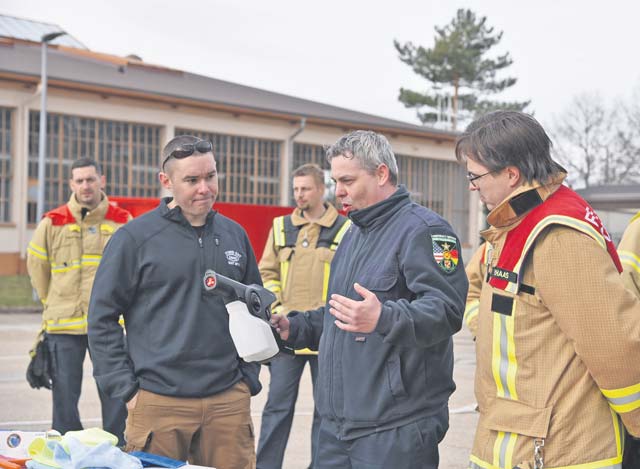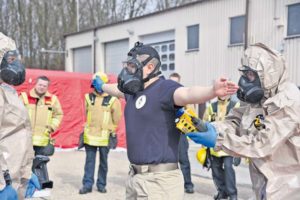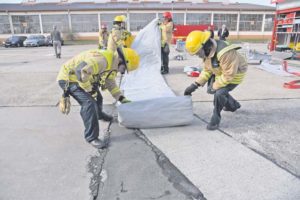
U.S. Army Garrison Rheinland-Pfalz firefighters participated in decontamination training with the 773rd Civil Support Team to demonstrate capabilities and interoperability in Sembach, March 6.

Garrison firefighters from Kaiserslautern East Fire Station 1, Sembach Fire Station 2 and Miesau Fire Station 3 exhibited their skills by deploying a decontamination trailer containing tents, equipment and purification materials to perform mass decontamination procedures during emergencies.
Although the instances are rare, decontaminating victims during crisis situations do happen, said Andreas Grawert, USAG RP assistant fire chief.
“This is not something that we do in our every-day jobs,” said Grawert, a 33-year fire department veteran. “But we are prepared to immediately respond to incidents involving hazardous substances and provide decontamination of personnel at the scene, if needed.”
The event also provided cohesion between the garrison’s three main fire stations that had the tough task of constructing three large tents and setting up decon areas and hazardous water/material containment as one team.
The training was a great opportunity for them to work together, Grawert said.
“Depending on the severity of the situation, more than one fire station may have to deploy to a scene involving hazardous materials. Currently, three installations — Baumholder, Germersheim and Miesau Army depots — have this capability, but all garrison firefighters need to know how to set up the tents and equipment,” he said. “This helps them become one team by working together, as well as with the 773rd CST.”
The CST is a specialized unit that has the ability to quickly respond to chemical, biological, radiological or nuclear incidents within the U.S. European Command area of operations, said First Sgt. Carol Balderas with the 773rd.

“The mission of the CST is to support civil authorities at the direction of 7th Mission Support Command while at EUCOM CBRN incident sites by identifying CBRN agents and substances, assessing current and projected consequences, advising on response measures and assisting with requests for additional support,” Balderas explained. “During this exercise, we are partnering with the garrison fire department to improve training, tactics and procedures for interoperability and best practices to further support garrison response operations.”
Their expertise is critical when garrison firefighters respond to an incident involving hazardous materials. CST members have the ability to survey the scene and collect samples to test at an on-site mobile laboratory. The team’s expedient response and testing, determines what the hazardous material is comprised of and how to mitigate it safely — saving time and possibly lives. The team can also advise garrison firefighters with decontamination procedures at the scene, making the training valuable for both teams.
“It’s important to quickly verify what type of hazardous material is at the scene — for instance, if we determine the substance to be a chemical that’s highly reactive to water, firefighters may have to use foam to decontaminate people and mitigate the hazard at the scene,” said 773rd CST Commander Lt. Col. Eric Samaritoni. “This information could be critical for the incident commander to make informed decisions.”
Grawert agreed with the commander.
“Preparedness is the key, because these type of incidents can happen at any time. Our teams working together can save time and help lessen the dangers of the situation,” he said.
USAG RP Fire Chief Marshall Fiedler said enabling our allies through partnership and training is important within Rheinland-Pfalz.
“Assisting our community partners inside the gate as well as outside is vital. The 773rd is a tremendous force multiplier for our hazardous material response capability. Their training and expertise is second to none,” he said. “This particular training session’s focus was to review the decontamination capabilities of each unit and discuss procedures for personnel, tool and equipment decontamination. They are an impressive group of motivated Soldiers, and we look forward to continuing to develop our partnership.”







